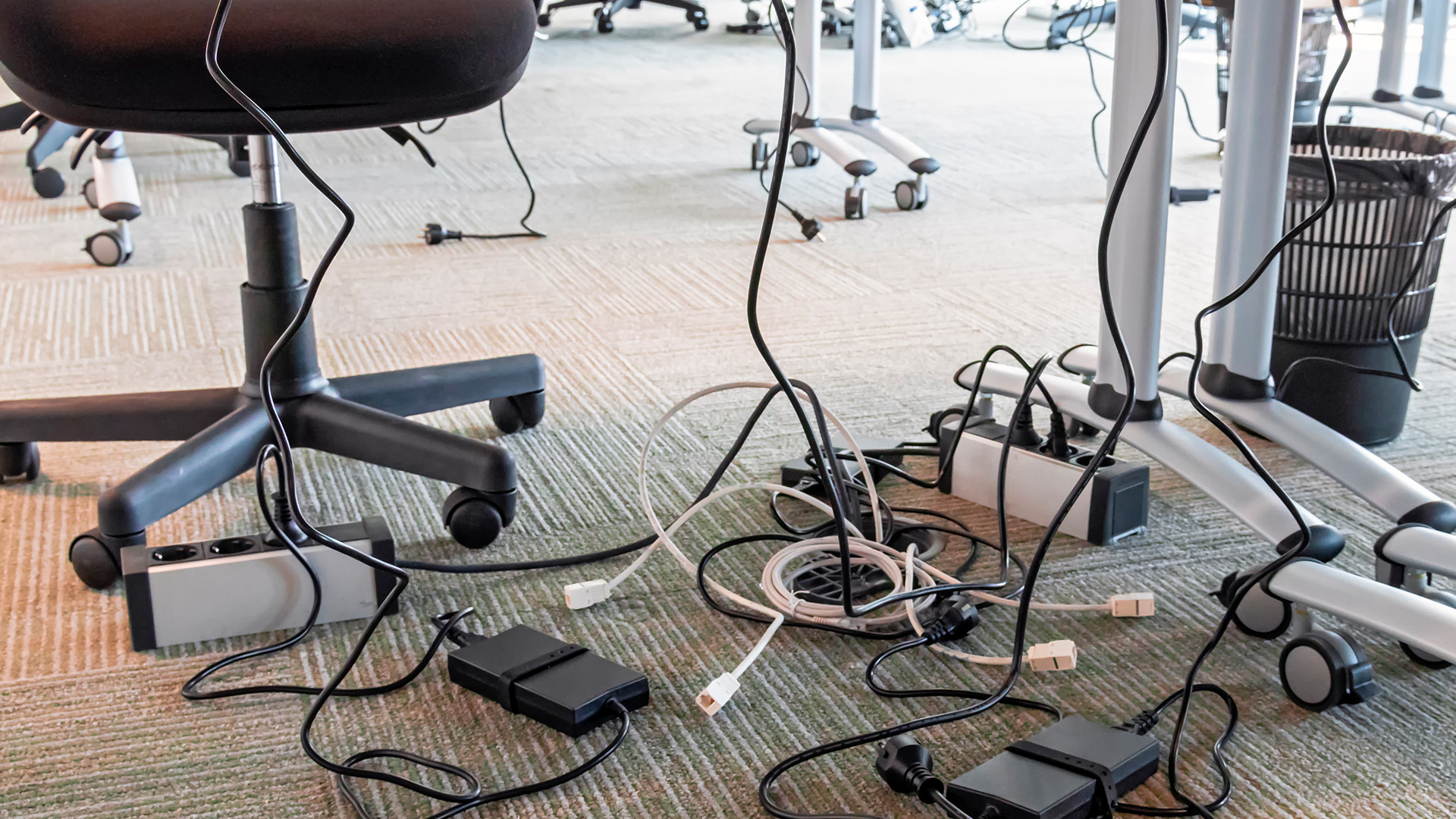Workplace safety is vital to the well-being and health of your business. Not only is it your business’s legal responsibility to protect your employees, but doing so can positively affect your company’s productivity and success. In this post, we’ve broken down five common workplace hazards. Then we’ll talk safety tips that can make your workplace safer for everyone.
10 Common Workplace Hazards
- Electrical Hazards
- Tools or Machinery Hazards
- Fire Hazards
- Chemical Hazards
- Falls and Falling Objects
- Ergonomic Hazards
- Noise Hazards
- Biological Hazards
- Confined Spaces Hazards
- Temperature Extremes
Electrical Hazards
The three main types of injury from electrical hazards are fires, burns, and shocks. These injuries are often caused by faulty wiring, ineffective or broken equipment, or misuse by an employee. The most common type of electric hazard is shock, which can occur when exposed wiring that has electricity running through it comes into contact with skin. Even a moderate shock can lead to respiratory and heart failure. They can also cause electrical burning and fires.
Workplace Safety Tips to Prevent Electrical Accidents:
- Wear protective equipment at all times.
- Provide training when necessary and make sure employees are using equipment correctly.
- Never allow any employee to use faulty or broken electrical equipment.
- Before starting any work, make sure that the area doesn’t have any exposed circuits, or broken or exposed wires.
Tools or Machinery Hazards
These hazards are typically caused by a fault in the equipment, lack of employee knowledge and training, or management not enforcing safety precautions. They can result in cuts, abrasions, and even amputations. Whatever the cause, if an employee has a machinery accident on the job that results in harm to themselves, they are entitled to compensation of medical bills and expenses, depending on how, when, and where the accident occurred.
Workplace Safety Tips to Prevent Accidents from Tools or Machinery
- Only employees well trained in the machinery or tools should use them.
- Follow all safety precautions at all times.
- Wear necessary protective equipment at all times.
- Report accidents to management immediately.
- Monitor and maintain machinery and tools regularly to ensure that they are in good working condition.
Fire Hazards
Fires can occur at any time and place, regardless of the type of business. They can be caused by electrical shorts, faulty wiring, or even employee negligence. Regardless of the cause, fires can be extremely perilous hazards. If not handled swiftly and adequately, they can result in the destruction of property and employee injury or death.
Workplace Safety Tips to Prevent Fire Accidents:
- Always make sure that you have multiple working smoke detectors on every level of the workplace. These should be inspected, tested, and the batteries replaced every six months.
- There should be working, regulation fire extinguishers throughout the workplace and every employee should know where they are.
- Make sure you have the right fire extinguisher for your specific business needs.
- All employees should be trained on the fire exits, and the company should have periodic fire drills to ensure that employees know what to do in an emergency.
CPI Safety Tip: Enhance your peace of mind and protect your business 24/7 with a business security system from CPI Security. Our system actively monitors for emergencies, like fires and break-ins. Should your fire alarm go off, our professional monitoring team is able to verify the emergency, alert first responders in real-time, and remain in contact with those in your business with our two-way audio and video communication capabilities.
Chemical Hazards
Unlike the other hazards on the list, the effects of chemical hazards can be gradual, only becoming noticeable over an extended period. It’s possible to be exposed to chemical hazards through skin contact, inhalation, and ingestion. Side effects of chemical exposure can include organ failure, respiratory issues, or even cancer.
Workplace Safety Tips to Prevent Chemical Accidents:
- Employees should always wear protective equipment, covering the skin, face, and eyes at all times when handling hazardous material.
- Employee exposure to these materials should be limited to further reduce the chance of exposure and an accident.
- Regularly check all chemical containment equipment for leaks.
Falls and Falling Objects
Injuries related to falls and falling objects are more common than you may think. In 2019, 39,443 died in falls at work and home. Another 244,000 were badly injured in a workplace fall.* Your employees aren’t the only ones at risk of falling. Falling objects (say inventory from store shelves) also account for many reported injuries every year. The good news is that these types of injuries are avoidable with the proper foresight and equipment.
Workplace Safety Tips to Prevent Falls and Injuries from Falling Objects:
Safety Tips to Prevent Falls in the Workplace
- Use the right equipment for the task at hand (ladders, cherry pickers, etc.).
- Never climb alone. Always ask a team member to spot you.
- Ensure your stepladders or regular ladders can be locked open.
Safety Tips to Prevent Injury From Falling Objects
- Use tool lanyards and leashes to keep tools from falling to the ground.
- Don’t store or place any objects on a leading edge.
- Make sure employees inspect and wear safety equipment when entering an area with potential fall hazards
5 Additional Common Workplace Hazards for 2024
Coming into 2024, we’ve identified a few more of the more common workplace hazards that you should know.
Ergonomic Hazards
Ergonomic hazards tend to occur when workstations or tasks are not designed with the worker’s body in mind, leading to repetitive strain injuries and musculoskeletal disorders. Common examples include: Improper lifting techniques, poor posture due to selected office equipment, and repetitive movements can cause these hazards. Without addressing ergonomic risks, employees can suffer from long-term injuries and chronic pain, which can decrease productivity and increase absenteeism.
Workplace Safety Tips to Prevent Ergonomic Hazards:
- Ensure that workstations are adjustable and designed to support good posture, reducing strain on the body.
- Provide employees with ergonomic tools and equipment, such as adjustable chairs, keyboard trays, supportive mats, and tools.
- Encourage employees to take regular breaks to stretch and change positions, reducing the risk of repetitive strain injuries.
- Train employees on proper lifting techniques and provide mechanical aids for heavy lifting tasks.
- Conduct regular ergonomic assessments to identify and address potential hazards in the workplace.
Noise Hazards
Noise hazards are more common in the construction, manufacturing, and entertainment industries and can lead to hearing loss, increased stress, and reduced productivity. Continuous exposure to high noise levels without proper protection can have long-term health effects on employees.
Workplace Safety Tips to Prevent Noise Hazards:
- Conduct regular noise assessments to identify areas with high noise levels and implement noise control measures.
- Provide employees with appropriate hearing protection, such as earplugs or earmuffs, and ensure they are trained on their proper use.
- Implement engineering controls to reduce noise at the source, such as using quieter machinery and installing sound barriers.
- Establish quiet zones or designated areas where employees can take breaks from noise.
- Monitor and enforce compliance with occupational noise exposure limits to protect employees’ hearing health.
Biological Hazards
When you hear “biological hazard”, you may think it’s only applicable to labs and other healthcare facilities, but these hazards can arise from exposure to bacteria, viruses, fungi, and other pathogens. This could include a simple flu if you work in an office environment, or something more serious if you work in agriculture or healthcare.
Workplace Safety Tips to Prevent Biological Hazards:
- Implement and enforce strict hygiene and sanitation protocols to minimize the risk of contamination.
- Employees who may be exposed to biological hazards should be provided with personal protective equipment (PPE) such as gloves, masks, and gowns.
- Ensure proper disposal of hazardous biological waste according to regulatory guidelines.
- Conduct regular training sessions on infection control practices and the proper use of PPE.
- Monitor and maintain ventilation systems to reduce the spread of airborne pathogens.
Confined Spaces Hazards
Confined spaces are often found in construction, mining, and manufacturing industries. Working in confined spaces presents unique risks, such as asphyxiation, toxic exposure, and difficulty in evacuating during emergencies.
Workplace Safety Tips to Prevent Confined Spaces Hazards:
- Conduct regular risk assessments before any work begins in confined spaces.
- Ensure all employees receive proper training on confined space entry procedures and emergency response.
- Ventilation systems are used to provide fresh air and remove hazardous gases or vapors from confined spaces.
- Implement a permit-required confined space program to control and monitor entry into hazardous areas.
- Provide appropriate rescue equipment and ensure that a trained rescue team is available when employees are working in confined spaces.
Temperature Extremes
Working in environments with extreme temperatures, whether hot or cold, can pose significant health risks such as heat stress, hypothermia, and frostbite. Industries like agriculture, construction, and food processing often expose workers to temperature extremes. Implementing effective safety measures can protect employees from these hazards.
Workplace Safety Tips to Prevent Temperature Extremes Hazards:
- Monitor weather conditions and adjust work schedules to avoid the hottest or coldest parts of the day.
- To prevent heat stress or hypothermia, provide adequate hydration and rest breaks in cool or warm areas.
- Supply appropriate clothing and personal protective equipment (PPE) for employees working in extreme temperatures.
- Educate employees on the signs and symptoms of temperature-related illnesses and how to respond.
- Engineering controls such as fans, heaters, and cooling systems are used to regulate temperatures in the workplace.
To Identify Hazards, Start with a Risk Assessment
Some hazards are more obvious (like potential falling objects), whereas others might be harder to spot. We recommend conducting a risk assessment to get a complete picture of your business’s potential hazard exposure.
A risk assessment is a process that determines and identifies any safety and health hazards posed in a workplace. It also investigates and analyzes the effectiveness of your current safety measures and proposes improvements to the workplace to ensure worker safety.
While accidents do happen, most hazards can be avoided with a bit of planning, training, and process implementation. Take the time to know what hazards pose the most significant risk to your employees, then put a policy in place to help keep your team safe.
For more safety tips on managing your business, as well as information about how to secure and optimize your business with a smart security system, visit the CPI blog to learn more.
Sources:




